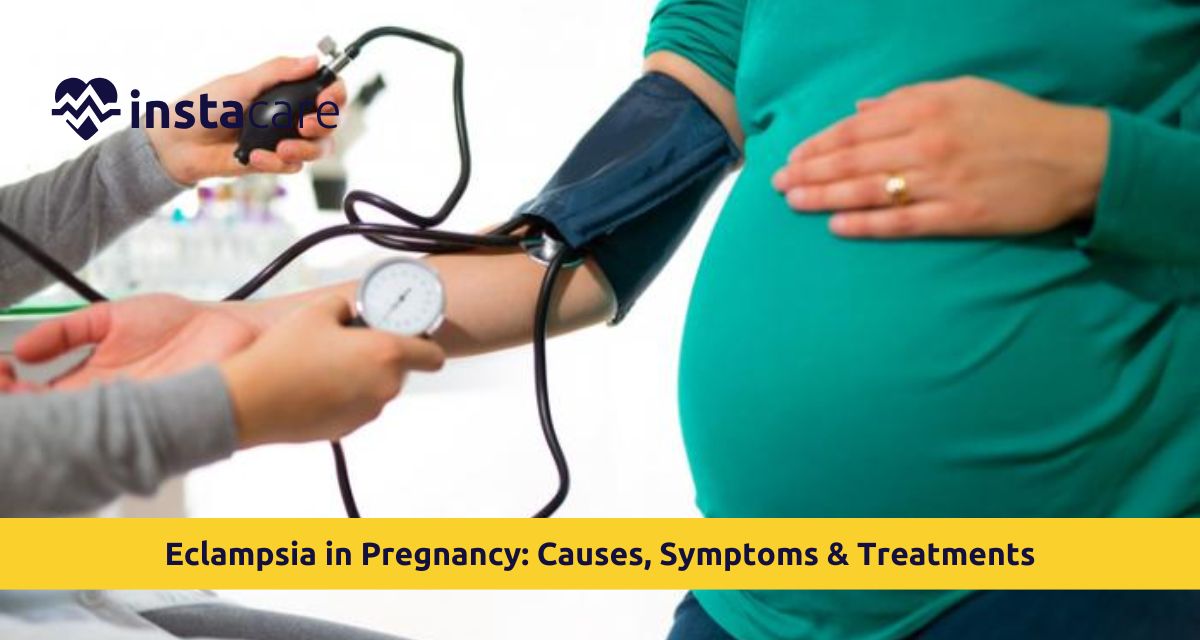The disorder typically occurs as a complication of preeclampsia, urinary protein abnormality, and hypertension. Since eclampsia is eclampsia as a complication of preeclampsia, the resulting seizures result in eclampsia, with acute onset and urgent danger for mother and child. Early diagnosis, optimal care, and immediate medical intervention are of utmost importance in an attempt to avoid severe sequelae and for best results for mother and child.
What is Eclampsia?
Eclampsia is a serious pregnancy-related complication that is defined by the development of eclampsia seizures in preeclamptic women. The most urgent manifestation of pregnancy-induced hypertensive disorders and a therapeutic emergency that needs to be treated on an urgent basis, eclampsia is manifested as tonic-clonic seizures lasting seconds to minutes.
Observe the difference between preeclampsia and eclampsia. Preeclampsia refers to the occurrence of urine protein along with
high blood pressure (140/90 mmHg or higher) after or at 20 weeks of pregnancy. Seizures occurring in preeclampsia convert the disease into eclampsia. Seizure onset has no relationship with any neurological disease but as a result of alterations in pregnancy alone.
Eclampsia can be antepartum (pregnancy), intrapartum (childbirth and delivery), or postpartum. Eclampsia can occur approximately 50% during pregnancy, 25% during childbirth, and 25% of the first 48 hours of childbirth. However, postpartum eclampsia can also be seen a few weeks following delivery, and thus measures still need to be followed even after childbirth.
Causes and Risk Factors of Eclampsia
The eclampsia causes are still not as clearly defined, but many predisposing conditions and mechanisms have been explained by research. The disease is thought to be induced by pathologic placentation and function, and maternal vascular disease at the systemic level. Placental implantation that is dysfunctional in early pregnancy may trigger a cascade of processes that result in hypertension, proteinuria, and ultimately seizures.
There are a few known risk factors for eclampsia:
- First-time pregnancy and multiple pregnancy (twins, triplets) are an increased-risk condition
- Maternal age very young (less than 18 years) and maternal age very old (more than 35 years)
- Underlying medical disease present prior to pregnancy such as diabetes, renal disease, autoimmune disease, and chronic hypertension
They are also other risk factors including:
- Obesity
- History of eclampsia or preeclampsia
- Family history of hypertension pregnancy disorder
- Ethnicity - There is an unequal rate of incidence of eclampsia among African American women
- Constricted pregnancy care, nutritional deficiencies, and constricted access to health-care services
Symptoms of Eclampsia
Eclampsia symptoms usually develop gradually, first with the development of symptoms of preeclampsia and then with later convulsion. Symptoms and signs include:
- Severe headache that is not alleviated by pain medication purchased over the counter
- Altered vision such as blurry vision or spots
- Pain in the upper abdomen especially below the right ribs
- Swelling and weight gain in the face or hands
The most common presentation of eclampsia is convulsions, preceded by neurologic presentation such as severe headache, confusion, or restlessness. Eclampsia's seizure is initiated by facial twitching and progression to generalized convulsions in the entire body. Women lose consciousness during convulsions, present with rigidity of muscles, and abnormal respiration.
Other manifestations include:
- Nausea and vomiting
- Reduced urine output
- Tachypnea
- Changes in mental status
- Recurrence of blood pressures of 140/90 mmHg or more
- Marked proteinuria
- Hyperreflexia and habitual epigastric pain
Read More: How To Calculate Pregnancy Months?
Complications of Eclampsia
Eclampsia complications are lethal and deadly to both mother and child. Complications in mother involve stroke as a consequence of severe blood pressure leading to permanent brain damage or death. Pulmonary edema, or fluid congestion of the lungs, can cause extreme respiratory distress in addition to respiratory failure.
The other maternal complications include:
- Failure or impairment of the liver
- Kidney damage
- Placental abruption (premature separation of the placenta)
- HELLP syndrome (Hemolysis, Elevated Liver enzymes, Low Platelet count)
All of them can become very dangerous very rapidly and ought to be attended to immediately by a physician. Eclampsia mortality rates for mothers still remain high, particularly among those populations that have no access to eclampsia emergency care.
Complications in the fetus are as severe and involve:
- Growth restriction
- Prematurity
- Placental insufficiency with secondary delivery of low oxygen and nutrients
The seizures can cause temporary reduction in placental blood supply, which results in fetal compromise or death. Most pregnancies complicated with eclampsia are forced to be delivered prematurely with the hope of salvaging mother and fetal lives, and this can result in complications of prematurity.
Diagnosis of Eclampsia
Eclampsia diagnosis becomes more clinical once the preeclamptic women have developed seizures. The diagnosis starts with the verification of preeclampsia by a blood pressure and proteinuria test. A reading of 140/90 mmHg or more on two or more readings with four or more hours separating them, combined with proteinuria, verifies preeclampia status.
Laboratory investigations are of vital use in the management and treatment of eclampsia:
- Complete blood count
- Platelet count
- Liver function tests
- Renal function tests
Uric acid is typically elevated, and lactate dehydrogenase can be elevated as a marker of cell damage.
Imaging studies can be ordered to exclude other causes of seizures and complications. Cerebral edema, hemorrhage, or other neurologic complications are typically revealed by head imaging, for example, CT or MRI. Fetal monitoring is more critical to diagnose baby's status and urgent delivery if necessary. Around-the-clock electronic fetal monitoring can monitor signs of fetal distress with maternal seizure activity.
Treatment Options of Eclampsia
Eclampsia treatment involves seizure control, blood pressure control, and optimal delivery time determination. Magnesium sulfate is also the gold standard drug for eclampsia seizure prevention and treatment. Eclampsia medications like magnesium sulfate for eclampsia are given intravenously and have been found to be superior to all other anticonvulsant drugs in managing seizures during pregnancy.
Blood pressure should be maintained close to normal because over-reduction is at the cost of placental perfusion. Medications like hydralazine, labetalol, or nifedipine are administered to regulate blood pressure to normal levels. Care is taken to maintain systolic blood pressure <160 mmHg and diastolic blood pressure <110 mmHg with effective maintenance of organ perfusion.
Emergency treatment of eclampsia involves urgent hospitalization to eclampsia unit where high-risk pregnancy is taken care of. Delivery planning is of topmost priority because women with eclampsia can be rushed for delivery to avert further complications. Mode and timing of delivery are determined by:
- Gestational age
- Mother's condition
- Baby's condition
- Response to therapy
Emergency cesarean delivery can be done in highly compromised conditions to salvage both lives.
Prevention and Management of Eclampsia
Eclampsia prevention also lies mostly in the hands of intensiveness of prenatal care and early detection of preeclampsia. Regular screening for blood pressure, urine protein, and symptom check on prenatal visits enable detection of women at risk. Clinicians utilize eclampsia management guidelines in the provision of uniform evidence-based care.
Low-dose aspirin has also been promising as a preventive agent for preeclampsia among women at high risk if initiated early in pregnancy. Calcium supplementation would be advantageous in women with low calcium diets. Interventions are most effective, however, when they are complemented by ongoing prenatal care and prompt treatment of the occurrence of hypertensive disorders.
Pregnancy as a whole is all about lifestyle adjustment such as:
- Healthy weight maintenance
- Body exercise (as advised by doctors)
- Proper nutrition
- Alcohol and smoking abstinence
High-risk women should be well monitored and followed through by specialists during pregnancy. Early diagnosis at the first sign of warning and early medical action are still the best method of eclampsia prevention and side effect avoidance.
Conclusion
Eclampsia is an obstetric pregnancy complication that needs immediate medical intervention and attention from expert professionals. Although the condition poses a risk, prompt diagnosis, appropriate management, and adequate medical intervention greatly enhance infant and maternal survival. Prevention and intervention include education on path to preeclampsia-eclampsia pathway, monitoring for warning signs, and ready access to health facilities.
Regular antenatal care is of most importance in eclampsia prevention and management, and its importance cannot be overstressed. Role of the health staff towards surveillance of high-risk pregnancy, patient education regarding warning signs, and early treatment cannot be overlooked. Ongoing research on the etiology and treatment of eclampsia on a continuous basis leaves much to be desired in prevention and outcome.
In pregnant women, knowledge of symptoms and risk factors prompts them to seek the right treatment at any time. Although eclampsia is a lethal condition, there has been immense saving of lives and minimization of long-term effects on both baby and mother due to advances in emergency and obstetric services for this complication.
Please book an appointment with the
Best Gynecologist in Lahore, Karachi, Islamabad, and all major cities of Pakistan through
InstaCare, or call our helpline at 03171777509 to find a verified doctor for your disease.

